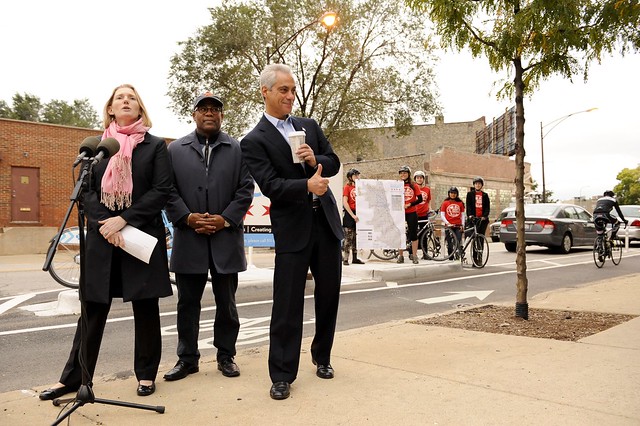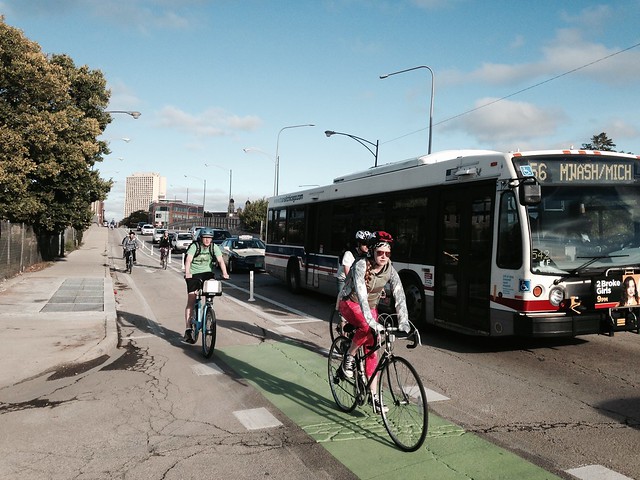CDOT Didn’t Hit 100-Mile PBL Goal, But They Did Transform the Bike Network
11:23 PM CDT on October 9, 2015

First, let’s get one thing straight. Despite what was stated today in the Chicago Department of Transportation’s press release, and local news reports based on it, the city has not achieved Mayor Rahm Emanuel’s goal of installing 100 miles of protected bike lanes in four years.
Emanuel’s Chicago 2011 Transition Plan set that ambitious goal for PBLs, which it defined as “separated from traveling cars and sit[ting] between the sidewalk and a row of parked cars that shield cyclists from street traffic.” However, after it became clear that it wasn’t going to be feasible to install that many miles of physically protected lanes within the mayor’s first term, CDOT adjusted its goal.
It certainly would have been reasonable for the department to announce that it would instead be putting in a mix of PBLs and buffered bike lanes. The latter are painted lanes with additional space striped on one or both sides to distance cyclists from moving traffic and/or opening car doors.
Instead, CDOT changed their terminology. By late 2012, they had begun referring to physically protected lanes as “barrier-protected” and buffered lanes as “buffer-protected,” and counting the latter towards the 100-mile goal. Since no other U.S. city refers to buffered lanes – merely paint on the road – as protected, that has caused plenty of confusion in the local and national media.
At a press event today by the Milwaukee Avenue bike lanes in River West, Emanuel announced that the city has surpassed the protected lane goal, with 103 miles installed to-date. “Investing in bike lanes is essential to growing Chicago’s economy and improving our quality of life,” he said. “We have made tremendous progress toward expanding our bicycle network for all Chicagoans, and we will continue to work towards making Chicago the most bike-friendly city in America.”
However, rather than 103 miles of protected lanes, CDOT has actually installed 19.5 miles, plus 83.5 miles of buffered lanes, since Emanuel took office. They’ve also put in 1.5 miles of neighborhood greenways (referred to as bike boulevards in other cities), and there are now 94 miles of conventional bike lanes, 46 miles of off-street trails, and 48.75 miles of sharrows (bike symbols with chevrons), for a grand total of 292 miles of bikeways.
While it’s a little disappointing that we’ve gotten less than a fifth of the protected lanes that were originally planned, we shouldn’t lose sight of the fact that 103 miles of BBLs and PBLs in a little over four years is still a major accomplishment. According to CDOT, Chicago has installed more physically protected lanes during the last four years than any other U.S. city did during the same time period.
Transportation commissioner Rebekah Scheinfeld dismissed the terminology issue as “a red herring.” “The point is, we’ve been providing better protected facilities, whether it’s a buffered, striped area or a physical, vertical barrier, through [flexible plastic posts] or concrete separation,” she said. “These are all great improvements over the simple striped design.”
“The whole intent [of the 100-mile goal] was to build better bicycling infrastructure, to give people low-stress environments so that they can choose biking as a healthy, active, and affordable way to get around the city,” Scheinfeld elaborated. She noted that CDOT has recently been going further with barrier protection. This year, concrete bike infrastructure was installed on Milwaukee, Sacramento Boulevard in Douglas Park, and Clybourn Avenue and Division Street in Old Town.
“It really is a fantastic milestone that we’ve reached, and we’re not stopping,” Scheinfeld said. At the presser, Emanuel announced that the city will be installing 50 more miles of bike lanes during the next four years.
The commissioner said these will include buffered and protected lanes, as well as neighborhood greenways, and the department will also focus on improving the connectivity of the bike network, upgrading existing lanes, and improving intersections. Personally, I’m hoping they’ll do something about the nightmarish, but heavily pedaled, junction of Logan Boulevard and Western Avenue.
It must be noted that this 50-mile goal is more conservative than the one stated in the City’s Streets for Cycling Plan 2020, released in 2012. That document called for the following by 2020:
- Continuous bikeways on all Spoke Routes
- An additional 50 miles of protected bike lanes
- An additional 30 miles of neighborhood greenways
- An additional 40 miles of bike lanes on Neighborhood Bike Routes
- Mark and/or sign all Neighborhood Bike Routes
Emanuel has recently come under fire for proposing a $588 million property tax hike. However, Scheinfeld said that the current 50-mile bike lane goal has nothing to do with budget issues.
Active Transportation Alliance cofounder Randy Neufeld, currently heading the SRAM Cycling Fund, said CDOT deserves kudos for building as many miles of buffered and protected lanes as they did, even if they didn’t hit the original target. “Their overall approach of doing what you can where you can is a good one,” he said. “You can’t let the perfect be the enemy of the good.”
Neufeld added that there has been a dramatic improvement in the city’s bike network over the last four years. “But we’ve been mostly making it better for the demographic of cyclists that’s already out there,” he said. “We haven’t really been cracking the mainstream yet. I think we need to be clear about what people want, and that’s physical separation from moving cars.”
Current Active Trans director Ron Burke agreed that the 103 miles of “advanced” bike lanes represents a sea change from what existed before Emanuel took office. “That plus the Divvy system has contributed to a tremendous surge in the number of people biking. The bottom line is that cycling probably is growing faster now than it ever has in the city of Chicago, certainly in the modern era.”
CDOT certainly deserves a round of applause for all the hard work they’ve put in over the past four years – it really has made a huge difference in the city’s bikeability. That said, the new 50-mile goal does seem a bit conservative. It would be great if a respected local advocacy organization was to step up to the plate and call for, say, another 100 miles instead. We’ll have to wait and see what happens…
In addition to editing Streetsblog Chicago, John writes about transportation and other topics for additional local publications. A Chicagoan since 1989, he enjoys exploring the city on foot, bike, bus, and 'L' train.
Stay in touch
Sign up for our free newsletter
More from Streetsblog Chicago
The de-facto ban on riverwalk biking is back. What should we do about it?
In the short term, new signage is needed to designate legal areas for cycling on the path. In the long term CDOT should build the proposed Wacker Drive protected bike lane.
Today’s Headlines for Thursday, April 25
It’s electric! New Divvy stations will be able to charge docked e-bikes, scooters when they’re connected to the power grid
The new stations are supposed to be easier to use and more environmentally friendly than old-school stations.




